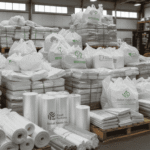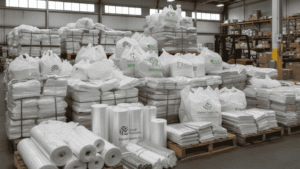
Ensuring Evidence Integrity: Importance of Tamper-Proof Bags

Maintaining the integrity of evidence is crucial for any law enforcement agency or investigating body. A small mistake or detail can impact the conclusion.
This is why tamper-proof bags are instrumental in all these sectors to keep the pieces of evidence protected, maintain their integrity, and guarantee the right findings.
Below are some reasons as to why these bags are important, how they work, and where they are used in this security-sensitive world:
Evidence Integrity Explanation
Evidence integrity is the degree to which evidence is well secured and protected from the scene till it reaches the court or the forensic lab. It guarantees that what is presented in the court for prosecution has not been tampered with, altered, or opened, but the exact details and information were obtained from the scene.
Any evidence that has been opened, unsealed, ripped, or not properly labeled is deemed an evidence flaw and therefore cannot be presented in court for prosecution.
This is why law enforcement and security personnel rely on special bags to keep their evidence safe.
What Are Tamper-Proof Bags?
Tamper-proof, or rather tamper-evident, bags are safe bags that indicate if the bag has been tampered with.
They are designed for securing specific items from unapproved access. Moreover, after the bag is sealed, it cannot be opened again without leaving traces that someone has tampered with it.
There are various types of tamper-proof bags:
- Forensic evidence bags are used to collect the materials used in the crime scene, such as fingerprints, lab samples, biological samples, or crime weapons.
- Currency or document bags for cash, legal papers, and sensitive files.
- Pharmaceutical and clinical bags for transporting lab samples or medical files safely.
How Tamper-Evident Bags Work
Most of the bags are equipped with a one-time-use adhesive tab that leaves a noticeable trace when someone tries to open them without authorization. Some of the bags also have a thermal indicator, a color change, or a void message for even trying to access the bag.
For instance, when an investigator seals a forensic evidence bag, the unique serial number and bar code are administered in the case record. If someone opens the sealed bag, the seal changes color, and the word VOID is articulated.
Other security seals may include:
- A heat seal that closes the bag permanently after exposure to heat.
- Mechanical locks or zippers with numbered seals.
- Barcoded tracking to keep a digital log.
All these features ensure a custody chain of layers of policing and forensic professionals.
The chain of custody is a specific record that reveals who identified, captured, transported, evaluated, and presented the evidence to the court and judges. Yet, many other types exist to help secure digital identification in case of invasion.
For scanning and easy tracking, tamper-proof bags usually have barcodes or QR codes. Every bag also has a serial number printed on it. This number allows a unique counting of each bag identified by law enforcement or forensic agencies.
Importance in Law Enforcement
Law enforcement values accuracy and trust. Law enforcement packaging must meet the requirements to prevent contamination and destruction of evidence that can lead to consequences.
Tamper-proof bags are therefore essential for the following reasons:
- It prevents evidence from being tampered with. Every time an officer seals the bag, it is not possible to access the evidence without leaving a visible trace.
- It is common for courts to examine not only the piece of evidence itself but also the process by which it reaches the court. If sealed bags show no evidence of tampering and a record of chain of custody, the evidence may more likely be admitted in court.
- It saves the only evidence.
Other Uses of Tamper-Evident Bags
Similar to law enforcement, tamper-evident bags have multiple applications and are commonly used in many other industries.
Banking and Cash Handling
In the banking sector and cash handling, banks and other financial companies use tamper-proof bags to move money, checks, confidential documents, and authorities’ reports safely inside and outside the organization.
In addition, these bags protect the contents from being stolen.
Healthcare and Laboratories
Forensic evidence bags and similar packaging are used in medical facilities and clinical laboratories to carry and transport tissue samples, test results, or secured drugs that comply with regulations concerning patient safety standards.
Corporate and Legal Sectors
Corporate firms and legal sectors also use tamper-evident bags to store important documents or digital storage devices. They ensure that no one else accesses the case’s private information.
Logistics and Shipping
Moreover, shipping industries have adopted the use of security seals together with tamper-evident packaging. The security measures ensure the integrity of the goods being shipped to the recipient.
Evidence Collection Practices
For evidence collection processes, tamper-evident bags must be used in compliance with specific conditions. Some of the following conditions include:
Seal Immediately After Collection
To minimize the chance of contamination, evidence should be placed in the bag and sealed right after collection.
Label Clearly and Completely
Document the case number, date, time, collector’s name, and a description of the evidence.
Use One Item per Bag When Possible
Separating items helps avoid cross-contamination and makes later tracking easier.
Check the Seal Before and After Handling
Look for signs of tampering and confirm that the bag’s serial number matches the records.
Document Every Transfer
Every time the bag changes hands, track the details in the chain of custody log. This creates full traceability.
Store in Controlled Conditions
Store sealed bags in secure, designated areas that limit access and have appropriate controls for the environment.
The Future of Secure Evidence Handling
Technology is always advancing the way we protect and trace materials and best practices.
Now, many tamper-evident bags come with advanced options, including RFIDs, GPS signals, and even chain-of-custody systems that allow real-time tamper detection and the elimination of human error.
Final Thoughts
Maintaining evidence integrity isn’t just about protecting an item — it’s about protecting justice itself. From the moment evidence is collected to the time it’s presented in court, every step must be secure, documented, and transparent.
Tamper-proof bags are used in law enforcement, at forensic labs, and by anyone else who ever handles sensitive materials.
If used responsibly, it not only preserves the evidence in its original state but also preserves confidence in the system.
Share:
Get A Quick Quote
Social Media
Most Popular


Creative Ways to Use Custom T-Shirt Bags for Brand Promotion

Wholesale Plastic Bags: The Cost-Effective Choice for Every Business

Top Ways Custom Packaging Builds Stronger Customer Loyalty
Categories
Tags
Related Posts

Top Vacuum Bags and Pouches to Keep Food Fresh Longer
Keeping food fresh is still a common concern for any residential or commercial kitchen. One of the easiest and most successful ways to help preserve

Creative Ways to Use Custom T-Shirt Bags for Brand Promotion
Let’s accept it. We often think of big advertising campaigns, billboards, or online ads when it comes to promoting a brand. But sometimes the simplest

Wholesale Plastic Bags: The Cost-Effective Choice for Every Business
Every business, big or small, relies on packaging to operate smoothly. From retail stores and grocery shops to warehouses and online sellers, packaging plays a
